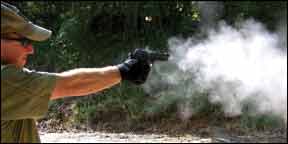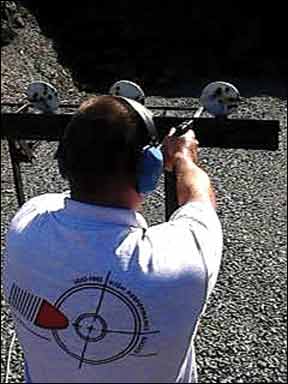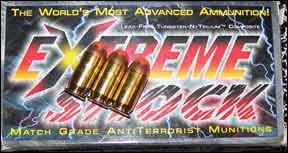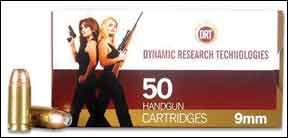This feature report on frangible ammunition was instigated by questions from readers. Most of the questions were along the same line: Can such-and-such ammunition possibly do what they say it does? Can a chunk of lead, fairy powder, or depleted uranium or other secret element possibly increase the effectiveness of a handgun bullet in the manner stated?

The concept of frangible ammunition has been around for a long time, but that doesnt mean that it is completely understood. As an example, during our rush to collect as many examples of these loads as possible, we found that otherwise knowledgeable gun-store clerks were mistaken concerning exactly what we were looking for. One of the fellows was asked to order frangible loads from as many different makers as possible. When our ammo came in the following week the clerk had batted .500. Half of the ammo was frangible, but the others were lead free loads, which are a different animal. We winced inwardly but paid up and smiled because this young man always gets the job done in a timely manner and is helpful in ordering the tons of ammunition we need every year.
Still, we managed to amass enough frangible ammunition to give the loads a fair shot. We were able to educate ourselves on the differences in frangible loads. In the past many writers, including our primary author, have referred to soft-point and hollowpoint loads as frangible. This is strictly correct only when you compare a fast-opening hollowpoint to a hard-cast lead bullet. Another term for frangible and hollowpoints alike has been exotic bullet styles – the Hydra-Shok or Silvertip is pretty exotic compared to a roundnose lead bullet. Just the same, there must be some consensus on what frangible ammo is.
Frangible ammunition is best described as a projectile designed to break up and disintegrate when meeting hard resistance, such as steel plates or a wall in a dwelling. Expansion is advertised in some cases, but those with powdered or sintered cores do not necessarily expand. Rather, they return to their original states. The concept is related to safety. Frangible bullets eliminate ricochet and limit overpenetration. They are useful in crowded environments and in providing safe training ammunition for use with steel targets or at very close range. There is no personal defense application intended or implied. The SinterFire is among the best-known examples of this type of bullet. There is always lethality involved, as the ammunition will perform much like a full-metal-jacketed bullet if it strikes flesh and bone. The loads are truly frangible only if hitting a steel plate or cinder block.

The second type of frangible includes the original Glaser Safety Slug. These are designed to break up when striking flesh and blood and absolutely guarantee that no part of the projectile exits the body. After over 30 years on the market, the facts are clear that the Glaser works as designed most of the time. Prison bureaus and big-city agencys SWAT teams have used these safety slugs. Sometimes called pre-fragmented, the Glaser relies upon compressed birdshot in a hollow jacket for effect. There are various competing types, including Extreme Shock and the DRT rounds. Each of these uses a different composition of frangible material, with the Extreme Shock depending upon nytrillium and the DRT relying upon a sintered core in a jacket. Since both types of loads are included in the frangible description, we tested both types.
Frangible Details
There are general comments applicable to each type. Neither is a conventional form of ammunition, although the standard frangible or type one is most similar to standard loads. By virtue of their unconventional construction, neither may be counted on for the same accuracy as a standard projectile, or at least that is the common wisdom. Look at all of the development in perfectly cast lead bullets and jacketed bullets with just the right jacket material and the correct balance of lead and copper and the correct depth of a hollow point. Frangible type-one bullets are constructed of sinters of metal. They are like metal sawdust, in a manner of speaking, in the first type of bullet. It is similar to the process that makes for constructing press board furniture from sawdust.
Metal particles are formed or glued together in a special bonding process. While the bullet is solid enough to endure the rigors of loading and unloading – usually – when it strikes a hard surface, the bullets cohesion is shattered. This type of load was developed for military training. Many materials have been used, including wooden bullets for short-range training. Plastic bullets are common for short-range training in Europe, but they have little application past very short range. While it is beyond the scope of this article, the widest use of frangible loads came from the Air Force. Frangible bullets were used for target training. One aircraft towed a training drone while the assigned fighter made passes with frangible ammunition. These loads were fully functional in .50-caliber machineguns. They broke up on the drones aluminum skin, registering hits, but did not damage the skin badly, so the drone could be targeted over and over. Frangible training ammunition was drawn into the police field when agencies began chartering realistic training scenarios with vehicles as a range fixture. Frangible loads were needed to ensure safe firing into vehicles doors and other car parts. At one time, perhaps half of the FBIs shootings involved felons in vehicles, so this was important training. Other agencies used steel-plate targets in Hogans Alley-type training at short range. The danger of splashback is very real. Frangible ammunition solved a lot of problems.

New frangible designs came along when the first wave of aircraft hijacking struck in the 1960s. There was great concern for safety and impetus for creating a sky marshal program. (Aside: the pilots flying the China Clipper and flying into Latin countries were issued Colt 1903 pistols, some of which were marked United Airlines!) Kurt Cannon developed the original Glaser Safety Slug. The term Safety Slug had two components of safety. First, it was designed not to penetrate the skin of an airliner. We have serious reservations concerning the explosive decompression feared by some, after all, the airliner has to breathe or the passengers would suffocate, and a pistol bullet hole probably would be insignificant. Still, a frangible slug was deemed a good idea. (Colt developed a .357 Magnum revolver with a plastic cylinder that fired ceramic bullets as one answer more closely related to the type one frangible.) The Glaser is a bullet jacket with no core. The bullet jacket is filled with birdshot, either #12 with the Blue Cap or #6 with the Silver cap. The bullet nose is a composition similar to bondo. Since the bullets are light weight for the caliber, they may be driven to high velocity. When the bullets impact, the jacket opens and the birdshot travels in clumps, shredding tissue. We have seen autopsy photographs of Glaser hits, and they look like a lead snowstorm. The only real problem with the concept is that the load may underpenetrate. A second concern that was very evident in early renditions was accuracy. The bullets were practically handmade, and the loads of birdshot were not consistent, so accuracy was very poor. As the late Jack Lewis commented in one special report, The Glaser Aint a Laser. Since Dakota Ammo (Cor-Bon) obtained the rights to the Glaser name, there has been considerable improvement. Another concern was function in self-loading handguns. Since the Glaser is lighter than standard loads, the question of cycle reliability has to be answered. Considering the dollar-a-cartridge-plus price of these rounds, a reliability program may be expensive. We have fired enough Glaser safety slugs to assure that they are reliable in the test pistol, but you must take responsibility for your own safety and commit to a reliability program. For this reason, many recommend the Glaser as a revolver round.
The Players
We collected three samples of type one frangible ammunition from two sources, Fiocchi and Speer, in two calibers, 9mm Luger and 45 ACP. We also collected a quantity of SinterFire bullets in 9mm, 40 S&W and 45 ACP and used a limited number in a handloading program.
Our test loads were Speer Lawman 9mm 100-grain RHT ($29.95 for a 50-round box); Speer Lawman 45 ACP 155-grain RHT ($32/50); and Fiocchi 9mm 100-grain SinterFire ($25.48/50).
Those interested in personal defense are far more interested in the type two frangible, so we collected a total of six of the type-two frangibles from Glaser, Extreme Shock, and DRT. The test was not a pure head to head because the type-two frangibles were in two calibers, 9mm and 45 ACP, but that was all we could obtain, and it was weeks in the waiting for these. Just the same, our experience and testing will give a broad perspective on what happens when bullets hit flesh.

The type-two rounds were the Glaser Safety Slug 45 ACP Blue No. 04600, which cost $21.74 for a six-pack, and Glasers Safety Slug 45 ACP Silver No. 04800, also $21.74 for six. Extreme Shock Enhanced Penetration 45 ACP No. EPR05 185-grain loads were $13.46 for 10 rounds, as was the Extreme Shock Fang Face No. 0FF05 45 ACP 185-grain load. Extreme Shocks Air Freedom 45 ACP 125-grain No. AFR05 ran $16.29 for 10 shots. Dynamic Research Technologys Terminal Shock 85-grain JHP 9mms cost $34 for a 50-round box.
How We Tested
We fired the usual accuracy test program and also fired into our standard test media, gallon water jugs. However, due to the nature of the test program, we also tested the frangible nature of the cartridges and their durability. As a rule, as part of our test examination, we soak a round or two of ammunition in water, old oil, and solvent. We also rack a round into the chamber several times. This is vital for a personal defense cartridge. If the loading fails, there is no point in testing ballistics. In this case, we didnt see any pushing of the bullet back into the case with any of the loads tested. However, one of the handloaded 9mm rounds broke the nose off the bullet on the fifth removal from the chamber. We have heard reports of this problem in the past, although it goes further than the design of this training ammunition is intended to perform. Our conclusion is that sintered bullets are not as viable in rough handling as standard solid bullets. This is not a big deal because these are training loads, so keep that in perspective.
The first tests were the type-one frangibles. We have seen commercial videos of shooters firing at a range of a few inches into a steel plate. Not us, too much risk. We fired at the common steel gong. However, we made a box that goes around the gong. This box would tell us if the bullet disrupted on the gong. We would find either powder in the box if the SinterFire bullet worked as advertised, or we would find chunks of bullets. One of our raters has done range-safety evaluations in the past, and the gongs we used were set up to deflect the bullets to the ground, and they certainly did so. The box short-circuited this deflection, but did so safely. But with the frangibles, there was no point worrying. They broke up on the gong. These bullets were designed for safety in training exercises when federal agents used steel plates inside vehicles at very close range. Many years ago Charles Kelsey designed the Devil round, which used a compressed core and flutes in the bullet to instigate bullet disruption. The new loads strike us as being very similar.
Speer Lawman 9mm 100-Grain RHT, $29.95/50
Speer Lawman 45 ACP 155-Grain RHT, $32/50
Fiocchi SinterFire 9mm 100 Grain, $25.48/50
Notably, Speer sells its Lawman loads primarily to law enforcement. Like many other LEO loads, civilians can obtain the product if you look hard enough at gun shows, but it doesnt offer anything that other readily available loads do not. (A quick Internet search showed no less than three concerns offering the SinterFire Lawman ammunition.) Speer quality control is evident, but this is training ammunition. Speer does not advertise these loads as anything other than ammunition designed to break up on metal targets and, as such, they are less likely to ricochet and damage range constructs. They are also lead free. The Fiocchi load is much the same. SinterFire also offers these bullets as projectiles only for reloading. The primary concern in handloading frangibles is to watch the crimp, as you may damage or even break the bullet.
Our test program began with firing frangible loads at a box that was wrapped around the steel gong. After firing 10 rounds into the box, we removed the box and emptied the contents onto our truck hood. In every case, the only thing left was sintered material – just as advertised. In contrast, when we shot a half-dozen rounds of conventional FMJ bullets into the box, ricochets tore the box to pieces with no bullet material recovered. With the Glaser and DRT and the Extreme Shock Air Freedom, only a few pieces of bullet jacket were found in the box. With the Extreme Shock Fangface, larger pieces were found, and with the Enhanced Penetration load there was a larger chunk of something that blew through the box.
Our Team Said: We have confidence in the frangibility of the SinterFire bullets loads for training. The type-two frangibles also seem to be safe training loads, but they are not as ideal as the type ones. After our test of the Type One loads in both 9mm and 45 caliber, we came to the conclusion that they are great training rounds, but they are not suitable for personal defense. The bullets are frangible, and that means they may break in the chamber. They are accurate enough for training, but not as accurate as the better class of jacketed bullets. For the most part, they are not produced with the same case-mouth seal and primer seal as defensive loads, because there is no need. They are training rounds. When it came to the water jug test, the results confirmed our impression. We did not waste too much in the way of expensive water jugs as both the 9mm and 45-caliber rounds easily penetrated over 30 inches of water with no parts of the bullet left in any of the jugs.
These Type One loads were all accurate and reliable, and all broke up on steel exactly as designed. Thus, their top grade. However, we cannot recommend any of them for personal defense.
GUN TESTS GRADE: A
Dynamic Research Technologies
Terminal Shock 9mm JHP 85 Grain, $34/50
The DRT load is very interesting. Recoil is light, even for a 9mm with a 85-grain bullet. After reading all of the advertising claims, we still did not expect what happened. Performance was almost startling. Upon impact, the first water jug was torn apart, while the second was peppered with fragments. There were several entry wounds in the second jug. These fragments came to rest in the second water jug, with an estimated 10 inches of penetration by the fragments.
Our Team Said: The Dynamic Research Technologies rounds performed very well. The DRT loading was accurate enough, broke up exactly as designed with adequate penetration within the type, and offered light recoil. This is a new load without a verifiable track record in the field, but our test results are very promising.
GUN TESTS GRADE: A
Glaser Safety Slug 45 ACP Silver
No. 04800, $21.74/6
The Glaser Silver was more impressive. While the Blue load expired in 6 inches or less of water, the Glaser Silver tore into the second jug and released its payload. The jacket and larger shot were found laying in the base of the second jug. We estimate 10 inches of penetration.
Our Team Said: We recommend the Glaser Silver for personal defense use. That recommendation is based upon the fact that the Glaser Sliver will penetrate more in flesh and blood, but it still offers true Glaser performance. By the same token, a Silver bullet will break up in exactly the same fashion as the original when meeting a steel plate, curb, or mailbox on the street. The penetration is short by conventional standards, but the load performs exactly as designed, and the Glaser is accurate enough for personal defense. If you cannot tolerate overpenetration, this is the load of choice for our testers.
GUN TESTS GRADE: A
Extreme Shock Fang Face No. 0FF05
45 ACP 185 Grain, $13.46/10
The Fang Face is designed for comparable penetration and effect to modern JHP bullets. Penetration was long enough to make any Martin Fackler fan pleased. The average was 16 inches, but some went 18 inches. In one case we had an 18-inch penetration with a fragment reaching a full 24 inches.
Our Team Said: The Fang Face round delivered enhanced penetration as advertised. And this is why we are doing this test, to make readers aware of the difference in frangible loads. The Extreme Shock Fang Face is difficult to assess, but there is no question that the nose blows off and the rest of the bullet penetrates some 18 inches in water, which would correlate to about 15 inches in gelatin. This is not a conventional frangible by any means, but our testers said it is a load well worth considering if you are trying to deal maximum wound potential.
GUN TESTS GRADE: A
Extreme Shock Air Freedom 45 ACP
No. AFR05 125 Grain, $16.29/10
Extreme Shock has made some pretty outrageous advertising claims, and they have taken some criticism for this. Yet, there is a basis in the claims. The ammunition proved to be accurate, reliable, and durable in our testing. The Air Freedom round had the greatest energy of anything tested. One of our raters has fired hundreds of rounds with good results. (This is a Gun Tests rater, so the facts are verifiable.) However, Extreme Shock offers some rounds that are far more penetrative than the average frangible and they are advertised as such. They are true special-purpose loadings. You must know which one fits your needs.
Our Team Said: The Air Freedom load is a high-velocity light-bullet offering. Like all light-bullet loads, recoil with this bullet is correspondingly light, but these loads exhibited greater muzzle report and recoil than we expected during the firing test. We did velocity checks and firing for accuracy last, and discovered why. These loads were clocking a full 1350 fps, well over the advertised figure. There were no excess pressure signs, and the load remained controllable, but it was almost in +P recoil category. The Air Freedom loading completely expended itself in the first water jug, with no trace of the jacket or contents found in any example. As such, it is comparable to the Glaser Blue and not as suitable as the Grade A rounds for personal defense because of a lack of penetration.
GUN TESTS GRADE: B
Extreme Shock Enhanced Penetration
45 ACP No. EPR05 185 Grain, $13.46/10
This load also lives up to its name. The Enhanced Penetration load went a full 24 inches into water. This load is advertised as a good choice for entry teams. While penetration is there, the front half of the Enhanced Penetration blows off during testing. The Fang Face is much the same, although they differ in performance.
Our Team Said: This load offers considerably enhanced penetration while blowing the nose off. It is a very specialized load that would a good choice for those confronting heavier clothed thugs or those behind light cover. It is important to understand the differences in the Extreme Shock loadings. If you need this level of penetration, the Enhanced Penetration cartridge from Extreme Shock is an interesting loading.
GUN TESTS GRADE: B
Glaser Safety Slug 45 ACP Blue
No. 04600, $21.74/6
The oldest type of commercially available frangible designed for specialized personal defense is the Glaser Safety Slug. Currently, production seems to have produced efficient loadings that are suitable for use in the majority of automatic pistols, but we advise you check your handgun for compatibility with a firing test. Cycle reliability is as important as feed reliability. Some of our raters are old enough to remember Glaser loads that were very inaccurate and not always reliable in self-loading pistols. Often, the loads struck very low in relation to the point of aim. Cor-Bon has invested in powder research and tweaked the bullets.
During the accuracy test, the two loads tested were not only accurate, they struck to the point of aim, more or less. The Glaser Blue was dead on the money in our SIG P220 at 15 yards, while the slightly slower Glaser Silver was slightly lower on the target, perhaps a half inch. The Glaser Blue is topped with a blue plug and is the original concoction of a copper jacket filled with #12 bird shot. The Glaser Silver is topped with a gray plug and is designed to offer more penetration with its #6 shot. There is no difference in recoil. Both are very mild to fire.
Our Team Said: In the jug test, the Glaser Blue completely exhausted its payload in the first jug. There were only a handful of pellets remaining in the jugs. Even the jacket was blown away to who knows where, certainly not within a 5-foot radius of our firing bench. Arguably, this is in the design envelope, but in our view it didnt provide adequate penetration for personal defense. The Glaser Blue round is a proven cartridge, but shallow penetration remains a risk for those who may confront heavily-clothed attackers. In our opinion, the Glaser Blue suffers in comparison to the Glaser Silver.
GUN TESTS GRADE: B



























Greetings! Your article on Frangibles is absolutely the fines and most complete that i have seen anywhere on the Web. I have printed out your article and it is now in my notebook as a reference. I have since re-read the article many times and learn a great deal each time i do so.
Since your article was published, i found yet another type 2 frangible that might be of interest to you. It is the G2 RIP marketed by Firequest. This bullet, rather than using bird shot, it used a series of very sharp what looks like shrapnel pieces that when they separate they cut unto the body. Their claim is that is caused devastating damage. As with any claims, that may not be fully accurate for all i know. Anyway, should you find time, could you take a brief look at the ad and see if there is any use for this bullet in EDC/SD use. Thank you.